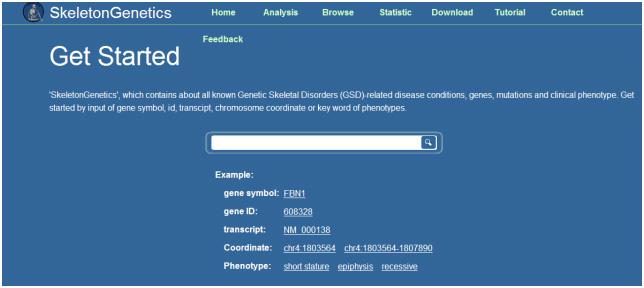
Using high-tech means such as gene sequencing, doctors at Wenzhou Central Hospital and Wenzhou Prenatal Diagnostic Center developed and built a genetic database for hereditary bone diseases, which was published on an international journal last week. This means that in the future, medical staff from different countries can find disease causes in the genetic database of hereditary bone diseases, so as to provide accurate treatment. The research is said to be the first international multifunctional integrated database on genes related to hereditary skeletal diseases.
Pocket-sized mom didprenatal screening to test genetic abnormalities for fear of disease heredity .
Mrs. Zhou, who has already become a mother, is a pocket mother with a height of less than 1.3 metersdue to chondrodysplasia. After getting married, what worries her the most is that her illness would be passed on to her children, and she was clearly told by the doctor that this was dominant, with a 50% chance of heredity.
At the beginning of last year, Mrs. Zhou worried a lot after she became pregnant, fearing that her child would be just like her. During the 15 weeks of pregnancy, she sought help from the genetic clinic of Wenzhou Central Hospital, where doctors performed genetic testing on Mrs. Zhou and found that she suffered from chondrodysplasia due to a mutation in FGFR3 gene. After 18 weeks of pregnancy, the doctor verified the genetic test on amniotic cells and found that the fetus did not have the FGFR3 gene mutation and was a healthy child.
After determining that the child was healthy, Mrs. Zhou was relieved. Late in her pregnancy, the doctor gave her another imageological examination, which finally ruled out the probability of a malformed child and found that the fetus in her body was developing healthily.
Deformed children were conceived twice by two healthy parents.
Five years ago, shortly after marriage, Mrs. Zhang successfully conceived, however, she was not able to experience the taste of being a mother, happiness came to an abrupt end. In time of foetal anomaly scan of the 24th-week pregnancy, doctors found that the fetus in her body has cleft lip and palate, short limbs, scoliosis, too much amniotic fluid, brain bulge and other symptoms, which showed that was a deformed child. Eventually, Mrs. Zhang had no choice but to terminate her pregnancy.
Initially, the family thought it was just an accidental case and took good care of Mrs. Zhang, who focused on preparing for pregnancy. One year later, Mrs. Zhang was pregnant again. Unexpectedly, 18 weeks after pregnancy, Mrs. Zhang went to the hospital to take a pregnancy test, butthe doctor was shocked by the result. According to B-scan ultrasonography, the fetus in Mrs. Zhang's body had similar clinical symptoms to the previous one. Mrs. Zhang had no choice but to tearfully abort the fetus.
Both husband and wife are healthy, how could they conceive a deformed child twice, which made Mrs. Zhang and herhusband puzzled, so they sought help from the Genetic Clinic of Wenzhou Central Hospital.
Doctors did a full genetic test on Mrs. Zhang and her husband, determined the pathogenic mutation sitesthrough more than 20,000 genes screening, and found that Mrs. Zhang and her husband are both carriers of the HSPG2 gene, which belongs to the invisible inheritance, with a one-fourth probability of heredity.
Although there is only a 25% chance of children being inherited, Mrs. Zhang, who has twice conceived a malformed fetus, does not dare to conceive easily again.
In order to make Mrs. Zhang and her husbandhave a healthy baby, the doctor suggested IVF. Now, Ms. Zhang has finally given birth to a healthy baby!
WenzhouPrenatal Diagnostic Center screened out nearly 100 cases of skeletal malformations last year.
According to incomplete statistics, the total incidence of hereditary skeletal diseases among people is approximately 1/1500. Last year, affiliated to Wenzhou Central hospital, WenzhouPrenatal Diagnostic Centerdetected nearly 100 cases of hereditary skeletal deformities, which ranked the third in aspect of birth defects, after cardiovascular diseases and neurological diseases.
Among nearly 100 cases of skeletal deformities, the most common ones are achondroplasia, pseudoachondroplasia, lethal dwarfism, fragilitus ossium, congenital syndactyly, hand and foot clefts, mucopolysaccharidosis, and other hereditary bone disorders.
"The genes given to everyoneby his or her parents can change." Tang Shaohua, director of the Prenatal Diagnostic Center of Wenzhou Central Hospital, said that when an individual's genes change, it can lead to genetic diseases and genetic defects, and congenital genetic defects can be screened out ahead of time through prenatal genetic test.
It is known that lying-in women usually undergo at least five antenatal examinations during pregnancy.
Three of them are more important:
The first one is 11-13 weeks plus 6 days, mainly excludes partial chromosomal abnormalities and certain severe malformations;
The second one is the mid-pregnancy screening at 18-24 weeks, commonly known as "Anomaly Scan", which can rule out many organ pathologies.
The third one is 28-32 weeks, mainly check fetal growth retardation and some late malformations.
In the interview, the reporter learned that the rate of fetal malformation is related to the ages of the pregnant women, the older they are, the higher the probability of chromosomal malformation in the fetus is. Some second-child mothers are elderly pregnant women, so the aging of the eggs, and chromosomal mutationsresult in fetal malformations.
With the loosening of the two-child policy and the increase in the number oflying-in women at advanced ages, pre-pregnancy and prenatal check-ups are essential to reduce the rate of birth defects and screen out genetic defects.
In this regard, doctors have reminded lying-in women, especially those at high risk of genetic mutations, those of advanced pregnant age, and those with a history of bone disease in the family, that they should go to the genetic clinic as early as possible during their pregnancy for counseling in order to find therapeutic regimen.
The first international genetic database on hereditary bone diseases was built in Wenzhou.

SkeletonGenetics
Database onGenes Related to HereditarySkeletal Diseases SkeletonGenetics